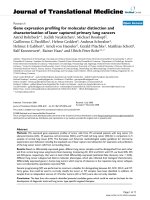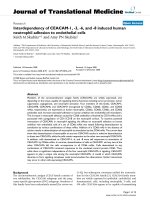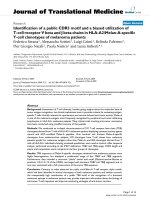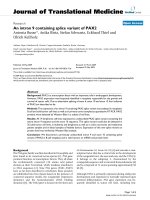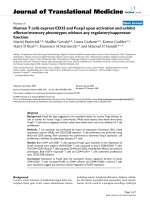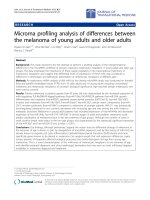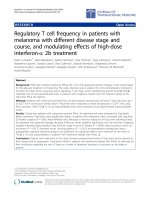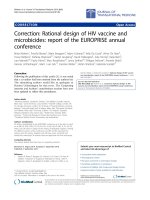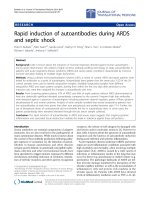báo cáo hóa học:" Cytotoxic T lymphocyte responses against melanocytes and melanoma" pptx
Bạn đang xem bản rút gọn của tài liệu. Xem và tải ngay bản đầy đủ của tài liệu tại đây (1.58 MB, 10 trang )
RESEARC H Open Access
Cytotoxic T lymphocyte responses against
melanocytes and melanoma
Gwendolen Y Chang
1
, Holbrook E Kohrt
1
, Tor B Stuge
1
, Erich J Schwartz
2
, Jeffrey S Weber
3
and Peter P Lee
1*
Abstract
Background: Vitiligo is a common toxicity associated with immunotherapy for melanoma. Cytotoxic T
lymphocytes (CTLs) against melanoma commonly target melanoma-associated antigens (MAAs) which are also
expressed by melanocytes. To uncouple vitiligo from melanoma destruction, it is important to understand if CTLs
can respond against melanoma and melanocytes at different levels.
Methods: To understand the dichotomous role of MAA-specific CTL, we characterized the functional reactivities of
established CTL clones directed to MAAs against melanoma and melanocyte cell lines.
Results: CTL clones generated from melanoma patients were capable of eliciting MHC-restricted, MAA-specific lysis
against melanocyte cell lines as well as melanoma cells. Among the tested HLA-A*0201-restricted CTL clones,
melanocytes evoked equal to slightly higher degranulation and cytolytic responses as compared to melanoma
cells. Moreover, MAA-specific T cells from vaccinated patients responded directly ex vivo to melanoma and
melanocytes. Melanoma cells express slightly higher leve ls of MART-1 and gp100 than melanocytes as measured by
quantitative reverse-transcriptase polymerase chain reaction (qRT-PCR) and immunohistochemistry.
Conclusions: Our data suggest that CTLs respond to melanoma and melanocytes e qually in vitro and directly
ex vivo.
Introduction
Recent FDA approval of ipilimumab for metastatic mela-
noma provides strong support for the ability of the
immune system to mediate a beneficial effect against this
disease. However, immunotherapies for melanoma,
including ipilimumab [1] and adoptive cellular therapies
[2], come with substantial toxici ties, including vitiligo
[3-5], ocular [6] and systemic autoimmunity [1]. As such,
a major need in next-generation melanoma immunother-
apy is to uncouple tumor immunity from autoimmunity
[7]. To improve the functional effectiveness of mela-
noma-reactive CTLs, understanding the factors leading
to recognition of self and the barriers to breaking
immune tolerance is crucial.
Two decades ago, pioneering work fr om the R osenberg
[8] and Boon [9] groups first demonstrated that T cells
infiltrating human melanoma often target self, non-
mutated proteins that are also expressed by normal
melanocytes. These include enzymes in the biosynthesis
of melanin, such as MART-1, gp100, and tyrosinase [10].
How these self tumor-associated antigens (TAAs) elicit
T cell responses in the context of melanoma remains
unclear. It is suggested that TAAs are overexpressed in
melanoma cells, thus eliciting responses by low avidity
TAA-specific T cells that escape central deletion [11,12].
If true, this offers an opportunity to target melanoma
without ha rming normal melanocytes by specifically eli-
citing low avidity TAA-specific T cells [13].
In this study, we address whether CTLs respond to
and target melanoma cells and normal melanocytes dif-
ferently. We utilized a set of MART- or gp100-specific
CTL clones that were determined to be high, intermedi-
ate, or low avidity (recognition efficiency, RE) based on
peptide titrations. We assessed both CTL degranulation
via mobilization of CD107, an integral membrane pro-
tein within cytolytic granules [14-16], and target cell
killing via chromium release assays. We also determined
if target cells express the cognate TAAs at similar levels,
and relate these to cytotoxicity.
* Correspondence:
1
Department of Medicine, Division of Hematology, Stanford University
School of Medicine, Stanford, California, USA
Full list of author information is available at the end of the article
Chang et al. Journal of Translational Medicine 2011, 9:122
/>© 2011 Chang et al; licensee BioMed Centra l Ltd. This is an Open Access article distributed under the terms of the Creative Commons
Attribution License (http://creati vecommons.org/licenses/by/2.0), which permits unrestricted use, distribution, and reproduction in
any medium, provided the original work is properly cited.
Materials and methods
Effector Cells
CTL clone s were generated using protocols as pre -
viously described [17]. Briefly, samples were obtained
from four different patients (the patients were anon-
ymously identified by numbers as “476” , “422”, “ 462” ,
“520” ) with resected stage III or IV melanoma patients
under informed consent approved by the institutional
review boards of the National Cancer Institute (NCI;
Bethesda, Maryland) and the Los Angeles County/Uni-
versity of Southern California; sample analysis was per-
formed under protocols approved by the institutional
review board of Stanford University. Peripheral blood
mononuclear cell (PBMC) samples were obtained from
patients after vaccination with melanoma-associated
antigens (MAA) peptides MART 26-35 (27L) (ELAGI-
GILTV) and gp100 209-217 (210M) (IMDQVPSFV) at
the University of Southern California Norris C ancer
Center (Los Angeles, California). The samples were ana-
lyzed by FACS for MAA-specific T cells using HLA-
A*0201/peptide tetramer-phycoerythrin (PE) made with
MART A26 or gp100 209-217 (Beckman Coulter).
Recognition efficiency and cytolytic c apability of each
CTL clone was determined as previously described
[15,17].
Target Cells
Melanoma cell lines Malme-3M, MeWo, A375 and the
T2 cell line were purchased from American Type Culture
Collection (ATCC, Manassas, Virginia), and mel526 was
obtained from the Surgery Branc h of NCI. Melan ocyte
line HeMn-MP 4C0197 was purchased from Cascade
Biologics (Portland, Oregon), and lines HeMn-LP and
HeMn-MP with lot numbers 3C0523, 3C0527, 3C0651,
3C0659, 3C0764, and 3C0661 were kindly provided by
Dr. Gary Shipley (Cascade Biologics). HLA-A *0201 status
was tested in each melanocyte lot using direct PCR by
the Stanford Histocompatibility Labo ratory (Stanford,
CA). T2 cells were pulsed and washed with either one of
the MAA peptides, MART 26-35 or gp100 209-217, at a
concentration of 10 μg/mL for 1 hour in 7% CO
2
prior to
each assay.
CD107 Mobilization Assay
All assays were done in duplicates with an effecto r to
target (E:T) ratio of 1:1, 2 × 10
5
of CTLs and 2 × 10
5
target cells in each well of 96-well plates. T2 cells were
prepared as described above. The following was added
each well in order: 1 μl of 2 mM monensin (Sigma, St.
Louis, Missouri) in 100% EtOH, 100 μl of target cells,
100 μl of effector cells and 1 μl each of CD107a-allophy-
cocyanin (APC) and CD107b-APC antibodies (Abs). The
cells are mixed well using a multichannel pipettor and
brought into contact by centrifugation at 1000 rpm for
1 min. Effectors and targets were incubated at 37°C in
7% CO
2
for 4 hours. A fter the incubation, the plates
were centrifuged at 1100 rpm for 1 min to pellet cells,
and the supernatant was remove d. Cell-cell conj ugates
were disrup ted by washing the cells using 1 x PBS with
0.02% sodium azide and 0.5 mM EDTA.
Flow Cytometric Analysis
After incubation with CD107 Abs, cells were washed and
further stained with anti-human CD8-FITC (Caltag
Laboratories, Burlingame, California; dilution of 1:200)
and CD19-CyChrome (Becton Dickinson, San Jose, CA;
dilution of 1:80). Cells were incubated for 1 hour at 4°C
and were washed twice before analysis. Cells were ana-
lyzed using a two-laser, four-color FACSCalibur (Becton
Dickinson). A minimum of 30,000 events were acquired
and analyzed using Flowjo (TreeStar, San Carlos, Califor-
nia). Lymphocytes were identified by forward and side
scatter signals, then selected for CD8 positivity and CD19
negativity. Gated cells were plotted for CD107 verses CD8
to determine level of T cell degranulation. Gates were ana-
lyzed for number and percentage of cells.
Chromium Release Cytotoxicity Assay and Determination
of Recognition Efficiency
Cytotoxicity was measured in a standard
51
Cr release assay
and all experiments were done in triplicates for each con-
dition. Briefly, target cells were labeled with
51
Cr for over-
night at 37°C in 7% C O
2
. T2 cells were pulsed with
peptides in conditions described above. Effectors were
incubated with targets at a ratio of 10:1 (E:T) for 4 hours,
and chromium release was measured. Percent cytotoxicity
was calculated using the mean of the triplicates. Cytotoxi-
city of each CTL clone is expressed by % specific lysis ± %
std dev. To determine the recognition e fficiency (RE),
chromium-labeled T2 targets were pulsed with a range of
native peptide concentrations, generally starting at 10
-6
M
and decreasing by log steps to 10
-14
M. For each CTL
clone, percent cytotoxicity was plotted against peptide
concentration and the negative log of the concentration.
The peptide concentration at which the curve crossed 40%
cytotoxicity was recorded as the RE of that clone. All
assays were done twice.
Quantitative Reverse-transcriptase Polymerase Chain
Reaction (qRT-PCR)
RNA from melanocytes, melanoma cells and unpulsed T2
were extracted as previously described [18]. cDNA synth-
esis was performed according to the manufacturer’sproto-
col using Superscipt II reverse transcriptase (Invitrogen,
Carlsbad, California) primed with oligo-dT. Oligonucleo-
tide primers used in qRT-PCR were synthesized based on
Chang et al. Journal of Translational Medicine 2011, 9:122
/>Page 2 of 10
published MART-1 and gp100 primer sequences [19].
Both primers were synthesized commercially by Elim Bio-
pharmaceuticals (Hayward, California); the primer
sequences are as follows: gp100(S): 5’-AGTTCTAGGGG
GCCCAGTGTCT-3’, (AS): 5’-GGGCCAGGCTCCAGG-
TAAGTAT-3’; MART-1 (Melan-A)(S):5’-TGACCCTA-
CAAGATGCCAAGAG-3’, (AS): 5’-ATCATGCATTGCA
ACATTTATTGATGGAG-3’. The real-time qRT-PCR
was performed in single wells of a 96-well plate (BioRad,
Hercules, California) in a 25 μl reaction mixture using
components of the Sybr Green qPCR system according to
manufacturer’s protocol (Invitrogen). Cycling of cDNA
involved denaturation at 95°C for 30s , a nnealing at 50°C
for 1 min and extension at 70°C for 1 min for 40 cycles
using the iCycler iQ
™
(BioRad). Fluorescence was mea-
sured following each cycle and displayed graphically (iCy-
cler iQ Real-time Detection System Software, version 2.3,
Bio Rad) . The software determin ed a cyc le thres hold (Ct)
value, which identified the first cycle at which the fluores-
cence was detected above the baseline for that sample or
standard. The Ct value of MAA divided by Ct value of gly-
ceraldehyde-3-phosphate dehydrogenase, an internal con-
trol,toexpresstherelative ratio of mRNA expression in
each cell line. Each qRT-PCR was performed in duplicate
and data represents the mean of the duplicate of relative
ratio in each condition.
Immunohistochemistry
Formalin-fixed paraffin-embedded sections were obtained
from primary or metas tatic tumors and surrounding skin
biopsies of patients with malignant melanoma in accor-
dance with protocols approved by Stanford University.
Monoclo nal antibodies to Mela n-A and gp100 (HMB45)
were purchased from DAKO (Carpinteria, CA) and immu-
nohistochemistry was carried out following the manufac-
turer’s recommended conditions. Samples were an alyzed in
the Department of Pathology by a single pathologist (EJS).
The extent of staining was scored as percentage of melano-
cytes or malignant cells testing positive for the presence of
either Melan-A or gp100. Each patient sample was then
assigned to one of three groups: < 5%, 5-20%, >20%.
Statistical analysis
Data are presented as mean ± standard error of mean.
Two-tailed Student’s T-tes t was used where appropriate
with significance defined at p < 0.05. Standard linear
regression analysis was used to determine correlation
between degranulation and cytotoxicity assays.
Results
HLA-A2 Characterization of Target Cells and Recognition
Efficiencies of Effector Cells
HLA-A*0201 status of each melanocyte cell line was ana-
lyzed using PCR-based analysis (Table 1). Melanocyte
lines 4C0197 and 3C0661 are HLA-A*0201-positive, while
3C0659 expresses two different alleles (HLA-A*0202/
0263) and 3 C0764 is HLA-A2 negative. Melanoma lines
Malme-3M, mel526, and MeWo are HLA-A*0201-positive
and express MAAs gp100, MART-1, and tyrosinase. A375
is also a HLA-A*0201-positive melanoma line but is defec-
tive in intracellular processing and MHC presentation of
gp100, MART-1, and tyrosinase [20]. MART-1 and gp100
specific CTL clones were previously isolated from PBM C
samples of four post-vaccinated m elanoma patients
[15-17]. Antigen specificity and recognition efficiency (RE)
of each clone are summarized in Table 2.
CTL Degranulation Upon Contact with Melanocytes
Compared to Melanoma Cells
To examine CTL degranulation in the presence of mela-
nocyte or melanoma cells, flow cytometric quantification
of surface mobilization o f CD107, an integral membrane
protein in cytolytic granules, was employ ed using pre-
viously established protocol [14-17]. Functional reactivities
of gp100 and MART-1 specific CTL clones in the pre-
sence of melanocyte lines HEMn-4C0197, 3C0661,
3C0659, and 3C0764 were compared with that in presence
of melanoma lines A375, mel526, and Malme-3M using
the CD107 degranulation assay. Two representative
CD107 mobilization FACS assays are plotted in Figure 1,
showing CTL degranulation of a high RE and an inter-
mediate RE gp100-specific clone (Figure 1).
Mean percent degranulation of six tested clones,
three gp100-specific (A) and three MART-1-specific
(B), of high, intermediate or low RE, are plotted
against each target cell line in Figure 2. For the high
RE, gp100-specific CTL clone, degranulation was ~90%
to both A2-positive melanocyte lines, versus 60-80% to
melanoma lines Malme-3M, mel526, and MeWo (Fig-
ure 2A). This represents a modest but significant dif-
ference (p = 0.02). Both MART-1 and gp100-specific
CTL clones of high avidity demonstrated a moderate
level (25-39%) of CD107 degranulation against 3C0764
(HLA-A2 negative) and 3C0659 (HLA-A*0202/0263)
melanocyte lines (Figure 2A and 2B, top panels). For
the other clones, degranulation to A2-positive melano-
cytes and melanoma cells were to similar levels, with
Table 1 Summary of HLA-A2 status in neonatal
melanocyte lines
Melanocyte Line HLA-A2 status
3C0651 (-negative)
3C0659 (-positive) A2*0202
(-positive) A2*0263
3C0764 (-negative)
3C0661 (-positive) A2*0201
4C0197 (-positive) A2*0201
Chang et al. Journal of Translational Medicine 2011, 9:122
/>Page 3 of 10
trends toward slight increases against melanocytes than
melanoma (p = 0.1-0.15).
Lymphocytes From Vaccinated Patients Are Reactive
Against Melanocytes Ex Vivo
Two PBMC samples isolated from peptide-vaccinated
patients were tested and found to be capable of eliciting
HLA-/MAA-specific degranulation against both HLA-
A*0201-positive melanocytes and melanoma directly ex
vivo (Figure 3). Of CD8+ T cells, 0.2-0.5% were gp100
pMHC tetramer-positive (Figure 3). Amongst pMHC
tetramer + CD8+ T cells isolated from patient 10820, 0%
degranulated against antigen-deficient melanoma A375,
11% degranulated against A*0201-positive melanocytes,
15% and 16% degranulated against melanoma lines Mal-
me3M and mel526. For patient 10839, 1%, 59%, 24%,
Table 2 Characterization of MART-1 and gp100 - specific CTL clones by recognition efficiency
MAA specificity Clone RE for native peptide (-log of peptide concentration, M) Functional Avidity
gp100 476.140 11.2 high
422.50 10.4 intermediate
476.105 8.3 low
MART-1 461.24 7.7 high
520.18 7.2 intermediate
520.31 5.1 low
Figure 1 Representative FACS plot showing degranulation in HLA-A*0201-restricted gp100-specific CTL clones. CD107 mobilization
quantification in gp100-specific, (A) high RE, and (B) intermediate RE CTL clones upon activation by target melanoma and melanocyte lines. CTL
clones demonstrated MHC-restricted, peptide specific response against target cells with RE corresponding to levels as previously described [17].
All melanoma cell lines are HLA-A*0201-positive; melanocyte lines 4C0197 and 3C0661 are A*0201-positive while 3C0659 and 3C074 are A*0201-
negative.
Chang et al. Journal of Translational Medicine 2011, 9:122
/>Page 4 of 10
Figure 2 HLA-A0201 melanocytes and melanoma cells elicit robust degranulation responses in high and intermediate RE cytolytic
T cells. (A) gp100-specific or (B) MART-1-specific CTL clones previously characterized as low, intermediate, or high RE [15,17] were incubated
with various lines of melanoma, melanocyte and peptide-pulsed T2 cells for 4 hours. Lymphocytes were gated for CD8-positive cells and %
population plotted for CD107-positivity was scored and plotted against each target cell line.
Chang et al. Journal of Translational Medicine 2011, 9:122
/>Page 5 of 10
and 47% of CD8+ tetramer+ T cells degranulated
against A375, A2-positive melanocytes, Malme3M, and
mel526, respectively. These results suggest that periph-
eral blood CTLs from vaccinated patients are reactive
against both melanoma and melanocytes directly ex
vivo, at similar extents.
Melanocytes are Equally Prone To CTL-Mediated Lysis as
Melanoma Cells
All CTL clones were functional and specific as demon-
strated by lysis of T2 cells presen ting relevant or irrele-
vant peptides (Figure 4). CTL lysis was HLA-restricted
and antigen-specific, as HLA-A2 unmatched melanocytes
and antigen-defici ent melanoma line A375 had low cyto-
toxicit y, ranging from 0-10%. For MART- specific clones,
cytotoxicity reached 80-90% against A*0201-positive mel-
anocyte lines compared to 40-80% against A2-positive
melanoma lines by high RE clones (p = 0.19), and 40-50%
against melanocytes versus 15-25% against melanoma
cells by intermediate RE clones (p = 0.02). For gp100-
specific clones, cytotoxicity was 70-90% against melano-
cytes versus 35-60% against melanoma (p = 0.08) by high
RE clones, and 18-40% against melanocytes versus 15-
25% against melanoma cell lines (p = 0.6) by intermediate
RE clones. Low RE clones had little to no cytotoxicity
(<20%) against melanoma or melanocytes, even though
they had robust (95-100%) lysis against T2 pulsed with
the relevant peptide. These data represent a modest but
not statistically significant increase in CTL-mediated lysis
of melanocytes compared to melanoma, with the excep-
tion of the intermediate RE, MART-specific clone. A
robust correlation (r
2
= 0.80-0.88) was shown to exist
between the degree of cytolytic activity and degranulation
against various target cells, consistent with our previous
results e stablishing CD107 mobilization as both an indi-
cator of functional RE and target susceptibility [15,17,21].
Quantification and Comparison of Melanoma-Associated
Antigen Expression In Melanocytes Versus Melanoma
Cells
To examine if an increased level of MAA expression
underlies the strength of CTL-target interaction, we
employed qRT-PCR in examining whether the amount of
MAA mRNA may correlate with the extent of CTL degra-
nulation and cytotoxicity. A minor difference was seen
between the levels of MART-1 and gp100 mRNA expres-
sion in melanocyte and melanoma cells (Table 3). In
HLA-A2-positive melanoma cells, MART-1 expression is
1.23-fold and gp100 expression is 1.11-fold higher than
those expressed in A*0201-positive melanocytes (p <
0.015). In addition, skin biopsies from melanoma patients
were analyzed by a semi-quantitative approach to
Figure 3 Degranulation responses in ex vivo PBMC samples from peptide-vaccin ated melanoma patients against melanocyt e and
melanoma cell lines. PBMC samples were collected from two post-vaccinated melanoma patients (patient identification numbers 10820 and
10839). FACS plots demonstrating CD107 versus CD8 levels in the two patient samples after contact with the target cell lines. CD8-positive cells
were further gated, showing percentage of CTLs staining positive for CD107 mobilization.
Chang et al. Journal of Translational Medicine 2011, 9:122
/>Page 6 of 10
characterize surface MAA presentation in both benign and
malignant tissue. As shown in Table 4, expression of both
MART-1 and gp100 wa s variable in each of the samples.
However, 3 out of the 5 samples (Cases 2, 3, and 5)
expressed comparable amounts of MAAs in both melano-
cyte and melanoma clusters. In most cases (Cases 2-5),
>20% of both melanocytes and melanoma cells expressed
MART-1.
Figure 4 High and intermediate RE CTL clones are cytolytic to HLA-A*0201 melanocytes and mela noma cells.Averagecytolysisof
melanoma, melanocyte, and T2 targets by high, intermediate, or low RE MART- (A) or gp100-specific (B) CTL clones. Cytotoxicity of each CTL
clone is expressed by % specific lysis ± % std dev. All assays were done in triplicates and repeated.
Chang et al. Journal of Translational Medicine 2011, 9:122
/>Page 7 of 10
Discussion
Autoimmunity against melanocytes has been observed to
correlate with better clinical outcomes in malignant mela-
noma patients both anecdotally and in clinical trials of
immunotherapies [8,11,22-25]. Can this treatment-related
toxicity be uncoupled from anti-tumor activity? In this
study, to examine the association between tumor killing
and autoimmunity, MAA-specific C TLs were tested for
degranulation and cytolysis against melanocyte and mela-
noma targets. MART-1 and gp100-specific CTL clones of
high RE responded a gainst melanocytes and melanoma tar-
gets, with a trend toward higher reactivity against melano-
cytes tha n melanoma . High avidity HLA-A *0201-specific
clones non-specifically degran ulate against A *0201-negative
melanocyte lines at low levels insufficient for killing.
To address the notion that melanoma cells overexpress
MAAs and may be preferentially targeted by lower RE
CTLs that escape thymic deletion, we also analyzed reactiv-
ity patterns of intermediate and low RE CTL clones. Inter-
mediate RE, MAA-specific CTLs responded comparably or
slightly higher against melanocytes than melanoma cells.
Low RE, MAA-specific CTLs showed little to no response
against melanocytes and m elanoma cells, e ven though they
robustly lysed T2 cells pulsed with relevant peptide. Thus,
these data argue against a previously held notion that low
RE, MAA-specific CTLs can preferentially target
melanoma cells and not normal melanocytes. Rather, these
data suggest that MAA-specific CTLs respond against mel-
anoma and melanocytes equally in vitro. This is consistent
with a study showing melanoma lysis by vitiligo lesion-
infiltrating CTLs [26]. This is not limited to in vitro
expanded CTL clones, but also in directly ex vivo CTLs
from patients post-vaccination. Technical challenges
imposed by limited patient samples and low proportions of
tumor-specific CTLs in the PBMC do not allow for a more
detailed analysis or direct comparison to our in vitro obser-
vations. However, by selecting pMHC tetramer+, CD8+ T
cells which represent MART-1 or gp100-specific CTLs, we
observed similar levels of degranulation from these ex vivo
CTLs upon contact with HLA-A2 melanocytes as com-
pared to HLA-A2 melanoma cells.
In this study, there is a trend towards a lower degranula-
tion efficiency of MART-1 specific clones against T2 target
cells pulsed with MART peptides, when compared to
gp100-specific clones against T2 pulsed gp100 peptides. In
our previous studies, the RE scores observed for MART-1
specific clones presented with MART peptides were a t a
relatively lower range compared to clones presented with
other peptides [15-17]. We hypothesize that this is likely
due to the short predicted half-life of MART peptides
(native and heteroclitic) in complex with the HLA-A*0201
molecule. Moreover, Rubio-Godoy et al. [27] found discre-
pancy between CTL effector functions measured by cyto-
kine secretion and target cell lytic activities in their
tyrosinase-specific clones. In their study, T cell clones
detected by IFN-g ELISPOT but not detectable by pMHC
multimer staining wer e able to lyse tyrosinase peptide-
pulsed target cells as efficiently as those stained by pMHC
multimers. The authors attributed such differences to the
kinetics of pMHC-multimer interaction with TCR among
the clones studied. We speculate that while the lower
degranulation efficiency correlates to the low RE observed
for our MART-1 specific clone as expected, the high cyto-
toxicity observed may be a reflection of co-stimulation of
other cytokine production such as IFN-g following CD107
degranulation.
Vaccine immunotherapy for melanoma can be asso-
ciated with autoimmu ne effects of vitiligo. The incidence
of vitiligo in patients with melanoma, although rare, is esti-
mated to be seven to ten-fold higher than the general
population [28]. The occurrence of vitiligo in melanoma
patients undergoing immunotherapy may be due to both
Table 3 Relative ratio of TAA mRNA expression in each target cell compared to glyceraldehye-3-phosphate
dehydrogenase
Target Cell Antigen A375 Malme3M MeWo Mel526 4C0197 3C0661 3C0659 3C0764 T2 water
MART-1 0 1.225 1.21 1.315 1.035 1.06 1.085 1.08 0 0
gp100 2.295 1.285 1.225 1.3 1.195 1.115 1.23 1.175 0 0
GAPDH 11 11111110
Table 4 Immunohistochemistry staining for MART and
gp100 in melanoma and melanocyte clusters in 5
melanoma patient cases
#
Case Diagnosis MelanA gp-100 (HMB45)
20% 5-20% <5% > 20% 5-20% <5%
1 NA
Melanoma (SS) * *
2 IDN * *
Melanoma (recur) * *
3 JMN * *
Melanoma (SS) * *
4 IDN * *
Melanoma (SS) * *
5 IDN * *
Melanoma (Nevoid) * *
#
samples are scored based on percentage of melanocytes or malignant cells
which stained histologically positive for either MelanA (MART-1) or g p100 in a
given skin sample.
Chang et al. Journal of Translational Medicine 2011, 9:122
/>Page 8 of 10
qualitative and quantitative differences between the CD8+
T cells in the two diseases. In a murine model by Steitz et
al. [29], there appeared to be a two-step requirement for
MAA-specific CD8+ T cells to break tolerance in the
development of vitiligo. First, the stimulation and ex pan-
sion of MAA-specific CD8+ T cells requires CD4+ T cell
help in vivo during the “induction phase”.Then,inthe
“effector phase”, the CD8+ T cells require a strong local
inflammatory stimulus for autoimmune destruction of
melanocytes within the skin. Garbelli et al. [4] also
reviewed data supportive of a qualitative difference
between MAA-specific T cell respo nses in vitiligo and
melanoma. In the several studies rev iewed, CD8+ T cells
isolated from vitiligo lesions or patients were found to
have augmented functional avidity than those from their
melanoma counterparts.
From a quantitative standpoint, incidence of vitiligo
may be rare due to the low percentages of functional
CTLs against melanoma antigens in the peripheral
blood after vaccination. Our data is largely similar to
what had b een observed in other published studies. In
study by Jacobs et al. [30], the authors found that when
vitiligo occurs, MAA-specific CD8+ T cells were
observed in high percentages in both tumor and vitiligo
lesions, supportive of the hypothesis that vitiligo may
not be uncoupled from anti-tumor effect, and even indi-
cative of the success of immunotherapy. However, only
<0.2% of t he peripheral lymphocyte isolated from the
studied patient demonstrated MAA-specific tetramer
staining. In this study, <0.6% of peripheral blood lym-
phocytes from our post-vaccinated patient samples
demonstrated MAA-specific activity.
It is suggeste d that target recognition by CD8 T cells is
dependentuponacriticalthresholdamountofMHC/
MAA peptide expression on the cell surface [31-33]. Stu-
dies have shown that MAA expression may be highly vari-
able across various clinical stages and different melanoma
samples [34-36], with tumor escape from immune rec og-
nition achieved by loss of MAA or MHC expression
[36-40]. Our data suggest that melanocytes and melanoma
cells express MAAs at or above the recognition thresholds
of high RE CTLs, as these effectors lysed both targets
equally even though melanoma cells express the relevant
MAAs at slightly higher levels. In contrast, for intermedi-
ate and low RE CTLs, lysis of melanoma and melanocytes
was substantially below lysis of T2 pulsed with excess pep-
tide. As such, increasing MAA expression levels specifi-
cally in melanoma cells, in context of immunotherapy
with intermediate and low RE CTLs may be a possible
avenue to uncouple tumor immunity from autoimmunity.
Conclusions
Among the tested HLA-A*0201-restricted CTL clones in
this study, melanocytes evoked equal to slightly higher
degranulation and cytolytic responses as compared to
melanoma cells. Furthermore, MAA-specific T cells
from vaccinated pati ents responded directly ex vivo to
melanoma and melanocytes equally. These results sug-
gest that CTL recognition and killing of melanoma may
not be differentiated from autoimmune cytotoxicity of
normal melanocytes.
Acknowledgements
We are grateful to Dr. Gary Shipley of Cascade Biologics for providing the
melanocyte lines HeMn-LP and HeMn-MP used in this study.
Author details
1
Department of Medicine, Division of Hematology, Stanford University
School of Medicine, Stanford, California, USA.
2
Department of Pathology,
Stanford University School of Medicine, Stanford, California, USA.
3
Moffitt
Cancer Center, Tampa, Florida, USA.
Authors’ contributions
GYC carried out the biochemical studies, immunoassays, participated in the
statistical analysis, discussion of results and drafted the manuscript. HEK
carried out the immunoassays, participated in the discussion of results and
drafted the manuscript. TBS coordinated the pre-testing experiments,
contributed to the refinement of experiment protocol and participated in
the discussion of results. EJS performed the immunohistochemistry. JSW
selected the donors for the study. PPL conceived the study, participated in
its design and coordination and drafted the manuscript. All authors read
and approved the final manuscript.
Competing interests
The authors declare that they have no competing interests.
Received: 29 April 2011 Accepted: 27 July 2011 Published: 27 July 2011
References
1. Hodi FS, O’Day SJ, McDermott DF, Weber RW, Sosman JA, Haanen JB,
Gonzalez R, Robert C, Schadendorf D, Hassel JC, Akerley W, van den
Eertwegh AJ, Lutzky J, Lorigan P, Vaubel JM, Linette GP, Hogg D,
Ottensmeier CH, Lebbé C, Peschel C, Quirt I, Clark JI, Wolchok JD, Weber JS,
Tian J, Yellin MJ, Nichol GM, Hoos A, Urba WJ: Improved survival with
ipilimumab in patients with metastatic melanoma. N Engl J Med 2010,
363:711-723.
2. Dudley ME, Yang JC, Sherry R, Hughes MS, Royal R, Kammula U, Robbins PF,
Huang J, Citrin DE, Leitman SF, Wunderlich J, Restifo NP, Thomasian A,
Downey SG, Smith FO, Klapper J, Morton K, Laurencot C, White DE,
Rosenberg SA: Adoptive cell therapy for patients with metastatic
melanoma: evaluation of intensive myeloablative chemoradiation
preparative regimens. J Clin Oncol 2008, 26:5233-5239.
3. Yee C, Thompson JA, Roche P, Byrd DR, Lee PP, Piepkorn M, Kenyon K,
Davis MM, Riddell SR, Greenberg PD: Melanocyte destruction after
antigen-specific immunotherapy of melanoma: direct evidence of t cell-
mediated vitiligo. J Exp Med 2000, 192:1637-1644.
4. Garbelli S, Mantovani S, Palermo B, Giachino C: Melanocyte-specific,
cytotoxic T cell responses in vitiligo: the effective variant of melanoma
immunity? Pigment Cell Res 2005, 18:234-242.
5. Wankowicz-Kalinska A, Le Poole C, van den Wijngaard R, Storkus WJ,
Das PK: Melanocyte-specific immune response in melanoma and vitiligo:
two faces of the same coin? Pigment Cell Res 2003, 16:254-260.
6. Palmer DC, Chan CC, Gattinoni L, Wrzesinski C, Paulos CM, Hinrichs CS,
Powell DJ Jr, Klebanoff CA, Finkelstein SE, Fariss RN, Yu Z, Nussenblatt RB,
Rosenberg SA, Restifo NP: Effective tumor treatment targeting a
melanoma/melanocyte-associated antigen triggers severe ocular
autoimmunity. Proc Natl Acad Sci USA 2008, 105:8061-8066.
7. Bouwhuis MG, Ten Hagen TL, Suciu S, Eggermont AM: Autoimmunity and
treatment outcome in melanoma. Curr Opin Oncol 2011, 23:170-176.
8. Rosenberg SA, Kawakami Y, Robbins PF, Wang R: Identification of the
genes encoding cancer antigens: implications for cancer
immunotherapy. Adv Cancer Res 1996, 70:145-177.
Chang et al. Journal of Translational Medicine 2011, 9:122
/>Page 9 of 10
9. Boon T: Tumor antigens recognized by cytolytic T lymphocytes: present
perspectives for specific immunotherapy. Int J Cancer 1993, 54:177-180.
10. Kawakami Y, Robbins PF, Wang RF, Parkhurst M, Kang X, Rosenberg SA: The
use of melanosomal proteins in the immunotherapy of melanoma.
J Immunother 1998, 21:237-246.
11. Okamoto T, Irie RF, Fujii S, Huang SK, Nizze AJ, Morton DL, Hoon DS: Anti-
tyrosinase-related protein-2 immune response in vitiligo patients and
melanoma patients receiving active-specific immunotherapy. J Invest
Dermatol 1998, 111:1034-1039.
12. Guevara-Patino JA, Turk MJ, Wolchok JD, Houghton AN: Immunity to
cancer through immune recognition of altered self: studies with
melanoma. Adv Cancer Res 2003, 90:157-177.
13. Morgan DJ, Kreuwel HT, Fleck S, Levitsky HI, Pardoll DM, Sherman LA:
Activation of low avidity CTL specific for a self epitope results in tumor
rejection but not autoimmunity. J Immunol 1998, 160:643-651.
14. Betts MR, Brenchley JM, Price DA, De Rosa SC, Douek DC, Roederer M,
Koup RA: Sensitive and viable identification of antigen-specific CD8+
T cells by a flow cytometric assay for degranulation. J Immunol Methods
2003, 281:65-78.
15. Kohrt HE, Shu CT, Stuge TB, Holmes SP, Weber J, Lee PP: Rapid assessment
of recognition efficiency and functional capacity of antigen-specific
T-cell responses. J Immunother 2005, 28:297-305.
16. Rubio V, Stuge TB, Singh N, Betts MR, Weber JS, Roederer M, Lee PP: Ex
vivo identification, isolation and analysis of tumor-cytolytic T cells. Nat
Med 2003, 9:1377-1382.
17. Stuge TB, Holmes SP, Saharan S, Tuettenberg A, Roederer M, Weber JS,
Lee PP: Diversity and recognition efficiency of T cell responses to cancer.
PLoS Med 2004, 1:e28.
18. Chomczynski P, Sacchi N: Single-step method of RNA isolation by acid
guanidinium thiocyanate-phenol-chloroform extraction. Anal Biochem
1987, 162:156-159.
19. Jungbluth AA, Iversen K, Coplan K, Williamson B, Chen YT, Stockert E,
Old LJ, Busam KJ: Expression of melanocyte-associated markers gp-100
and Melan-A/MART-1 in angiomyolipomas. An immunohistochemical
and rt-PCR analysis. Virchows Arch 1999, 434:429-435.
20. Carrabba MG, Castelli C, Maeurer MJ, Squarcina P, Cova A, Pilla L,
Renkvist N, Parmiani G, Rivoltini L: Suboptimal activation of CD8(+) T cells
by melanoma-derived altered peptide ligands: role of Melan-A/MART-1
optimized analogues. Cancer Res 2003, 63:1560-1567.
21. Yee C, Savage PA, Lee PP, Davis MM, Greenberg PD: Isolation of high
avidity melanoma-reactive CTL from heterogeneous populations using
peptide-MHC tetramers. J Immunol 1999, 162:2227-2234.
22. Gogas H, Ioannovich J, Dafni U, Stavropoulou-Giokas C, Frangia K,
Tsoutsos D, Panagiotou P, Polyzos A, Papadopoulos O, Stratigos A, et al:
Prognostic significance of autoimmunity during treatment of melanoma
with interferon. N Engl J Med 2006, 354:709-718.
23. Nordlund JJ, Kirkwood JM, Forget BM, Milton G, Albert DM, Lerner AB:
Vitiligo in patients with metastatic melanoma: a good prognostic sign.
J Am Acad Dermatol 1983, 9:689-696.
24. Bystryn JC, Rigel D, Friedman RJ, Kopf A: Prognostic significance of
hypopigmentation in malignant melanoma. Arch Dermatol 1987,
123:1053-1055.
25. Boasberg PD, Hoon DS, Piro LD, Martin MA, Fujimoto A, Kristedja TS,
Bhachu S, Ye X, Deck RR, O’Day SJ: Enhanced survival associated with
vitiligo expression during maintenance biotherapy for metastatic
melanoma. J Invest Dermatol 2006, 126:2658-2663.
26. Le Gal FA, Avril MF, Bosq J, Lefebvre P, Deschemin JC, Andrieu M, Dore MX,
Guillet JG: Direct evidence to support the role of antigen-specific CD8(+)
T cells in melanoma-associated vitiligo. J Invest Dermatol 2001,
117:1464-1470.
27. Rubio-Godoy V, Dutoit V, Rimoldi D, Lienard D, Lejeune F, Speiser D,
Guillaume P, Cerottini JC, Romero P, Valmori D: Discrepancy between
ELISPOT IFN-gamma secretion and binding of A2/peptide multimers to
TCR reveals interclonal dissociation of CTL effector function from TCR-
peptide/MHC complexes half-life. Proc Natl Acad Sci USA 2001,
98:10302-10307.
28. Schallreuter KU, Levenig C, Berger J: Vitiligo and cutaneous melanoma. A
case study. Dermatologica 1991, 183:239-245.
29. Steitz J, Bruck J, Lenz J, Buchs S, Tuting T: Peripheral CD8+ T cell tolerance
against melanocytic self-antigens in the skin is regulated in two steps
by CD4+ T cells and local inflammation: implications for the
pathophysiology of vitiligo. J Invest Dermatol 2005, 124:144-150.
30. Jacobs JF, Aarntzen EH, Sibelt LA, Blokx WA, Boullart AC, Gerritsen MJ,
Hoogerbrugge PM, Figdor CG, Adema GJ, Punt CJ, de Vries IJ: Vaccine-
specific local T cell reactivity in immunotherapy-associated vitiligo in
melanoma patients. Cancer Immunol Immunother 2009, 58:145-151.
31. Rivoltini L, Barracchini KC, Viggiano V, Kawakami Y, Smith A, Mixon A,
Restifo NP, Topalian SL, Simonis TB, Rosenberg SA, Marincola FM:
Quantitative correlation between HLA class I allele expression and
recognition of melanoma cells by antigen-specific cytotoxic T
lymphocytes. Cancer Res 1995, 55:3149-3157.
32. Lethe B, van der Bruggen P, Brasseur F, Boon T: MAGE-1 expression
threshold for the lysis of melanoma cell lines by a specific cytotoxic T
lymphocyte. Melanoma Res 1997, 7(Suppl 2):S83-88.
33. Riker AI, Kammula US, Panelli MC, Wang E, Ohnmacht GA, Steinberg SM,
Rosenberg SA, Marincola FM: Threshold levels of gene expression of the
melanoma antigen gp100 correlate with tumor cell recognition by
cytotoxic T lymphocytes. Int J Cancer 2000, 86:818-826.
34. Barrow C, Browning J, MacGregor D, Davis ID, Sturrock S, Jungbluth AA,
Cebon J: Tumor antigen expression in melanoma varies according to
antigen and stage. Clin Cancer Res 2006, 12:764-771.
35. Murer K, Urosevic M, Willers J, Selvam P, Laine E, Burg G, Dummer R:
Expression of Melan-A/MART-1 in primary melanoma cell cultures has
prognostic implication in metastatic melanoma patients. Melanoma Res
2004, 14:257-262.
36. Urosevic M, Braun B, Willers J, Burg G, Dummer R: Expression of
melanoma-associated antigens in melanoma cell cultures. Exp Dermatol
2005, 14:491-497.
37. Khong HT, Wang QJ, Rosenberg SA: Identification of multiple antigens
recognized by tumor-infiltrating lymphocytes from a single patient:
tumor escape by antigen loss and loss of MHC expression. J Immunother
2004, 27:184-190.
38. Durda PJ, Dunn IS, Rose LB, Butera D, Benson EM, Pandolfi F, Kurnick JT:
Induction of “antigen silencing” in melanomas by oncostatin M: down-
modulation of melanocyte antigen expression. Mol Cancer Res 2003,
1:411-419.
39. Kurnick JT, Ramirez-Montagut T, Boyle LA, Andrews DM, Pandolfi F,
Durda PJ, Butera D, Dunn IS, Benson EM, Gobin SJ, van den Elsen PJ: A
novel autocrine pathway of tumor escape from immune recognition:
melanoma cell lines produce a soluble protein that diminishes
expression of the gene encoding the melanocyte lineage melan-A/
MART-1 antigen through down-modulation of its promoter. J Immunol
2001, 167:1204-1211.
40. Maeurer MJ, Gollin SM, Storkus WJ, Swaney W, Karbach J, Martin D,
Castelli C, Salter R, Knuth A, Lotze MT: Tumor escape from immune
recognition: loss of HLA-A2 melanoma cell surface expression is
associated with a complex rearrangement of the short arm of
chromosome 6. Clin Cancer Res 1996, 2:641-652.
doi:10.1186/1479-5876-9-122
Cite this article as: Chang et al.: Cytotoxic T lymphocyte responses
against melanocytes and melanoma. Journal of Translational Medicine
2011 9:122.
Submit your next manuscript to BioMed Central
and take full advantage of:
• Convenient online submission
• Thorough peer review
• No space constraints or color figure charges
• Immediate publication on acceptance
• Inclusion in PubMed, CAS, Scopus and Google Scholar
• Research which is freely available for redistribution
Submit your manuscript at
www.biomedcentral.com/submit
Chang et al. Journal of Translational Medicine 2011, 9:122
/>Page 10 of 10
